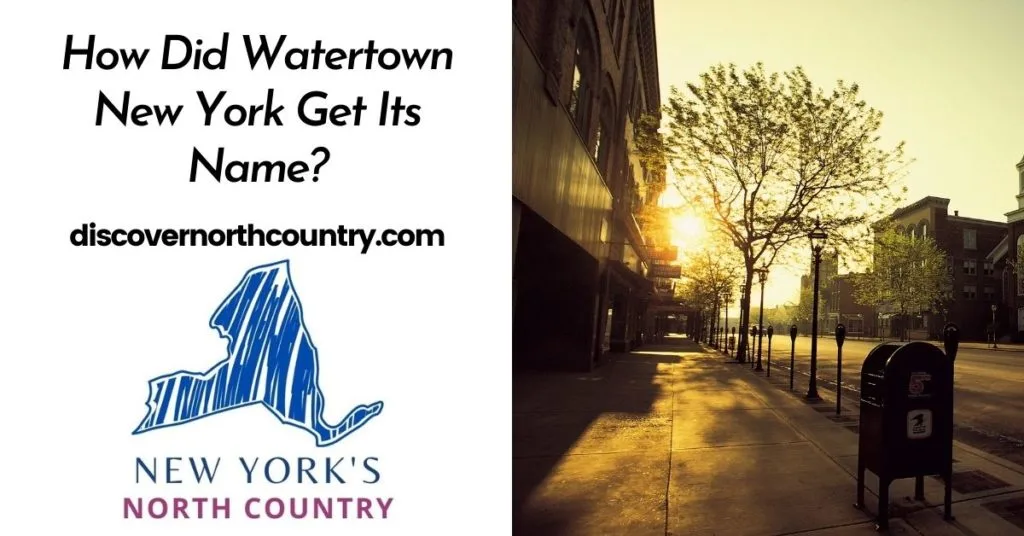Have you ever wondered how Watertown, NY got its name? In this post, learn the history of the name of Jefferson County’s biggest city.

One of the best reasons to visit Jefferson County, New York, is to explore some of the state’s most beautiful natural areas, such as Keewaydin and Southwick Beach State Parks. However, it’s always good to have the conveniences of Watertown nearby.
Is Watertown NY a town or a city?
One of the first questions I had when I started researching this article was what to call Watertown. Is it a town or a city?
The population of Watertown as of 2019 was estimated to be almost 26,000 people. Definitions of what makes a city vary, but most say that a city is inhabited by between about 25,000-50,000 people.
However, in the State of New York, there is no minimum population requirement or population density for a place to be called a city. Instead, a special legal process takes place to form a city, which is what occurred in 1869.
This means that in New York, Watertown in an official city. In addition, if you have ever driven around Jefferson County, you will have noticed that Watertown is the biggest place around.
In fact, it is the biggest population center in the entire region that many people refer to as North Country.
It has a mall, a movie theater, and almost every chain restaurant or store that you would ever need to shop in, and even has an international airport. In other words, it has everything that we have come to expect from a city.
So, Watertown is a city by the legal and traditional definition, and the story of how Watertown grew to its current size has everything to do with its name.
How did Watertown NY get its name?
Watertown got its name because of the Black River, which flows directly through the center of the city, dropping in elevation due to numerous falls, about 120 feet over a 2.5 mile stretch.
Watertown was originally founded in 1801 as a township, though European-Americans had been living in the area for at least a year prior to its official formation. It is also very important to mention that entire region including what is now Watertown was previously part of the Iroquois Confederacy, which held control over the area until the conclusion of the American Revolution.
The reason that the residents of the new settlement chose the name Watertown was because of the economic opportunity that the location presented. The early 1800s was the beginning of the Industrial Revolution in the United States, and a name like “Watertown” was perfect for a place with a strong, ample river that could potentially host mills.
Indeed, Watertown and the surrounding areas, were a great place for mills. By 1850, Watertown and nearby locales saw the construction of paper mills, grist mills, textile mills, saw mills, and other types of mills that benefited from the rivers in the area, especially the Black River.
Who chose the name of Watertown?
European-American settlers arrived to the Watertown, New York area in about the year 1800 from New Hampshire and other states in New England. The exact person who chose the name of Watertown is unknown, but it may have been a name that was agreed upon by Hart Massey, Henry Coffeen, and Zachariah Butterfield, a few of the most prominent early residents.
Why are there two places named Watertown in New York?
Did you know that there are two Watertowns in Jefferson County, New York? To make matters more confusing, they are right next to each other and have a common origin story.
When most people mention “Watertown”, they are probably referring to the City of Watertown, which is the main subject of this article.
However, not everyone knows that there is a Town of Watertown, with a population of just over 4,000 located on Route 11. The area of the Town of Watertown is the shape of a rectangle bordered to the north by the Black River.
However, the City of Watertown has been essentially “carved out” of the northern part of the rectangle, and is bordered by the Town of Watertown to the east, south, and west.
Both Watertowns were at one point the same place, but the area that is now the City of Watertown separated from the Town of Watertown by incorporating into a village, and then eventually into a city, which is the one that we know today.
The Town of Watertown still exists, much as it did back in the 1800s, with a government that is separate from the City of Watertown.
Conclusion
I hope you learned everything that you needed to know about the origins of the name of New York’s Watertown, which is not to be confused with the other Watertowns located in Massachusetts or South Dakota, among others.
All of those other Watertowns are probably awesome in their own way, but they can’t compare to Jefferson County’s Watertown, which is close to Canada, the St. Lawrence River, the Adirondacks, and Lake Ontario, all while being less than a day’s drive to New York City.
